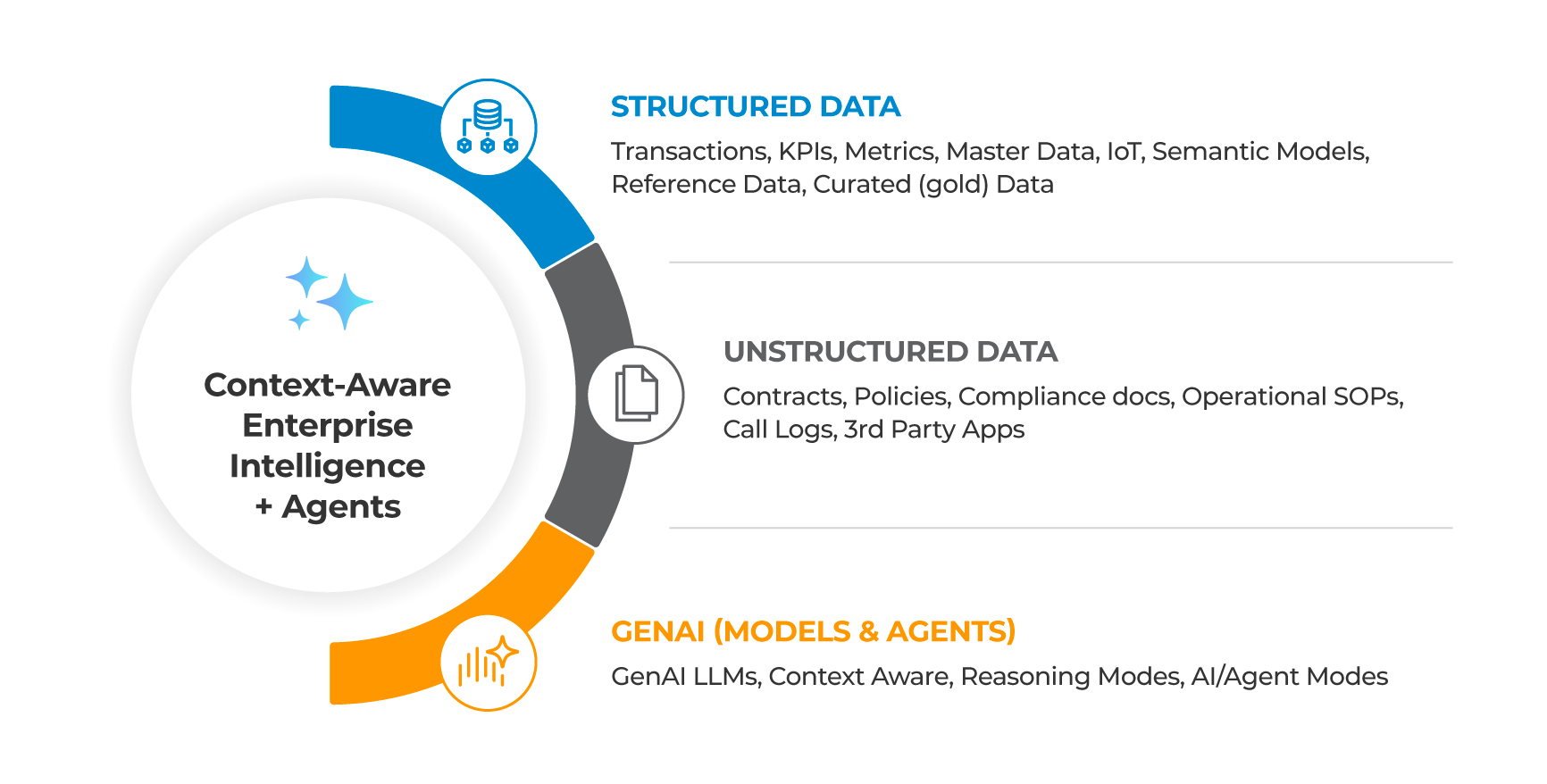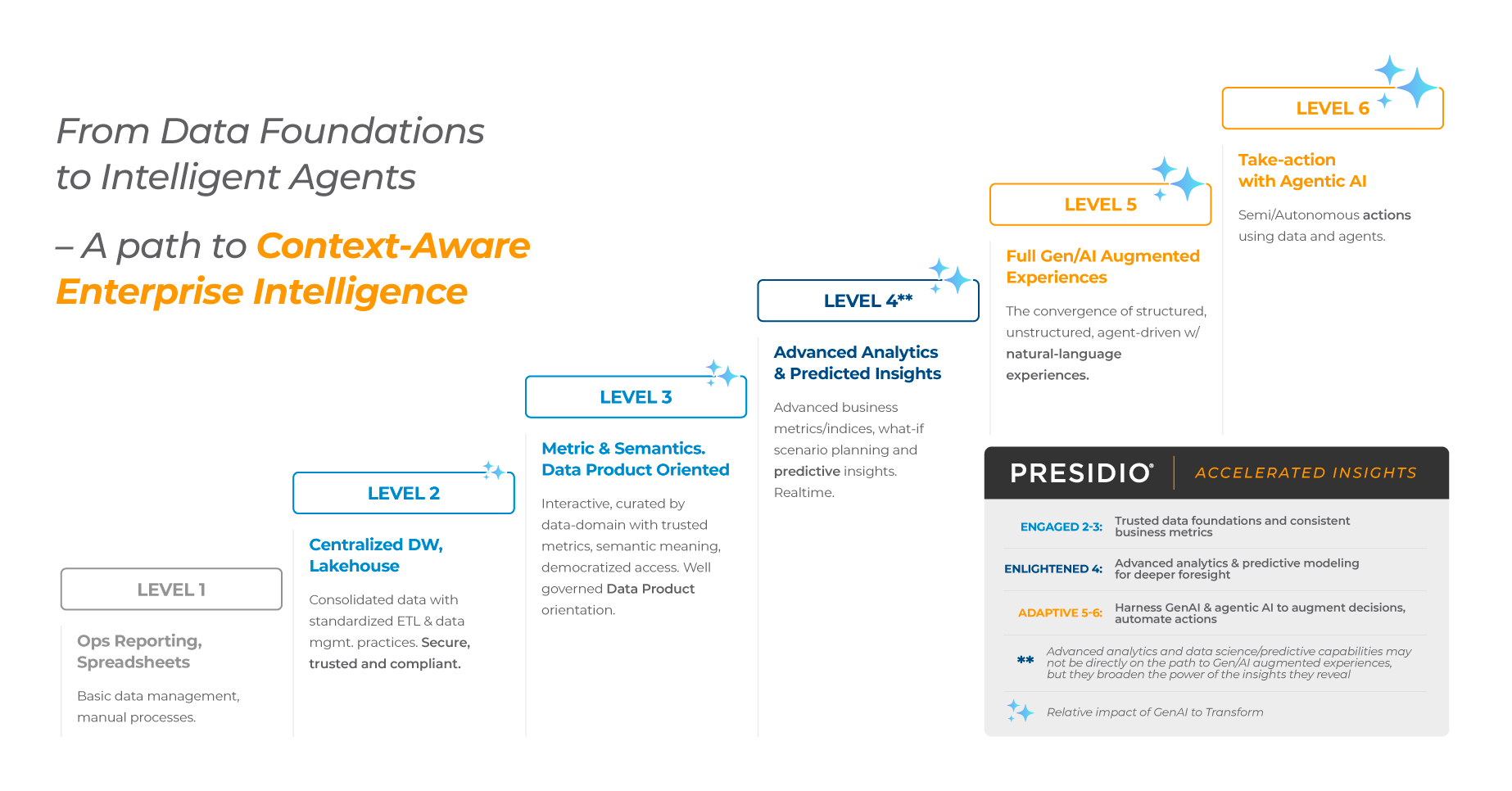
For nearly two decades, the classic data maturity model has been focused on descriptive business intelligence (what happened) -> predictive (what might happen) -> prescriptive (what should happen and why). These insights have guided organization’ data roadmaps.
But the approach to scaling data and analytics has shifted significantly. Generative AI is affecting data and analytics at every stage and bringing entirely new experiences to the data estate.
Major cloud data platforms like Snowflake, Databricks and Microsoft Fabric, are aligning their offerings, marketing and data-engineering patterns to adapt to the GenAI reality. The AI-powered experiences they are building can that leverage your firm’s data in novel and exciting ways.
Regardless of the industry or use cases therein, the transformative impact of GenAI is undeniable. It is prompting organizations to rethink not just their data architectures, but also how they extract value at every stage of the maturity curve.
ENGAGED: Moving Rapidly Beyond Reporting Silos & Fragmented Data
Level 1 is a bookend, as most organizations have moved beyond this stage. Here, data lives in silos, and insights are pieced together in spreadsheets or ad hoc reports. Teams often duplicate efforts, definitions vary across departments, and reporting lacks consistency or scale.
If you’re still here, the imperative is clear: move quickly to a modern platform.
Level 2 is where organizations begin building momentum. Data shifts out of spreadsheets and silos into a modern cloud data platform, which will prove to be a keystone asset.
Whether managed centrally or federated to departments, the point is consistent: data is organized, governed, and standardized. ETL pipelines, transformations, lineage, and security become routine, creating a foundation that scales.
Teams have the basis for aligning data artifacts to data products, a popular data organization structure for delivering value to stakeholders along value chain domains.
GenAI is already reshaping this level. AI-assisted development accelerates data (ETL) pipelines, optimizes SQL, aides in the development of data models, and enforces governance more efficiently than manual approaches. What once took hours now takes minutes, giving data teams more time to focus on business value.
At Level 3, organizations experience a significant transformation in how they approach and communicate data. The focus shifts from dealing with raw tables and rows to defining durable metrics – consistent, reliable measures of performance that are tracked and trusted over time. This stage involves contextualizing data, assigning semantic meaning, and enforcing business rules through these definitions.
Recently, Databricks and Snowflake have adopted the Microsoft Fabric approach, which has long leveraged the semantic modeling capabilities of Power BI. They are introducing a distinctively new semantic layer in their cloud data platforms. This innovation supports the rapid development of their own semantic modeling approaches and facilitates integration with their respective data catalogs.
By embedding semantic meaning, building trust, and establishing durable metrics – alongside disciplined organization of data artifacts such as tables and views, clear semantic and metric definitions, and the use of analytics tools – organizations enable a true data product orientation. This foundation supports the emergence of genuine self-service analytics across the enterprise.
Generative AI adds a new dimension by enabling natural language access to these metrics. Leaders can ask, “What was gross margin for Product A month over month?” and get a reliable, consistent answer. The BI experience becomes conversational – but only if the underlying metrics are defined and governed.
ENLIGHTENED: Advanced Analytics and Predictive Insights
At Level 4, organizations begin to look forward, not just backward, and experiment with novel analyses and simulations that help lift KPIs.
Advanced analytics and predictive modeling take curated data and use it for scenario planning and forecasting. Finance may model the impact of pricing changes on margins. Operations may simulate supply chain disruptions from trusted supplier, sensor, fleet and market/demand signals. These capabilities deepen the enterprise’s understanding of its position and opportunities in the market.
Historically, predictive insights required specialized tools and teams. Today, GenAI makes them more accessible. It acts as a pair-programming partner for analysts, helping generate code, suggesting models, and even reasoning through approaches. Machine Learning techniques like regression, forecasting, and classifications remain core, but GenAI can lower the barrier to entry and spreads experimentation across the business.
ADAPTIVE: The Context-Aware Enterprise Intelligence Emerges
Level 5 is where GenAI becomes the centerpiece. This is the rise of context-aware enterprise intelligence – a unified way of engaging with data through natural language and AI agents.
Employees no longer rely solely on dashboards. Instead, they interact directly with data: asking objective questions like “What was defect rate last month?” and following up with “Why was it higher than usual?” Agents connect structured data, BI metrics, unstructured documents, and even third-party applications to provide not just answers, but context and recommendations.
than usual?” Agents connect structured data, BI metrics, unstructured documents, and even third-party applications to provide not just answers, but context and recommendations.
Platforms are racing to deliver this vision. Snowflake, Databricks, and Microsoft Fabric are creating the infrastructure, orchestration and UIs for conversational, context-rich intelligence across the entire data estate and applications.
Presidio helps enterprises prepare for this leap by aligning data governance, enabling retrieval augmented generation (RAG) pipelines, and deploying agents that bring data and context together. This is where decision-making shifts from reactive to proactive, embedded into the daily flow of work.
Level 6 represents the frontier: agents that don’t just assist but act. These AI systems operate in semi-autonomous or fully autonomous modes, initiating workflows, executing tasks, and interacting directly with enterprise applications. A human may remain in the loop for oversight, but the shift is unmistakable: data-driven intelligence now extends into execution.
The major platforms are already laying the groundwork, with capabilities for defining, orchestrating, benchmarking, and governing agents alongside integration with large language models. Standards like the Model Context Protocol (MCP) and frameworks for logging, auditing, and cost control are emerging quickly to support safe adoption.
It’s early days, but the direction is clear. Modern data estates are becoming the natural home for agent orchestration, where structured and unstructured data, applications, and AI capabilities converge.
The Takeaway
The journey from spreadsheets to autonomous agents is not a straight line, and no two organizations will move at the same pace. But the imperative is the same: each step builds a stronger foundation for the next, and GenAI is accelerating progress at every stage. By combining modern platforms, strong governance, and new AI-driven experiences, enterprises can create data capabilities that are not just mature but transformative.
Presidio’s role is to guide that journey – bringing strategy, governance, engineering, and AI innovation together so organizations can realize value today while preparing for the opportunities of tomorrow.


